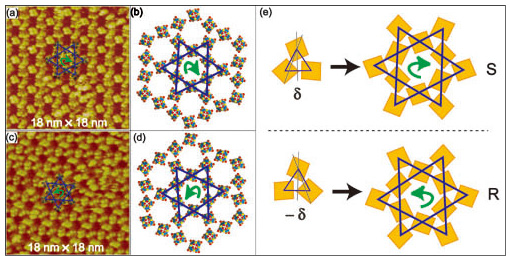Chiral Kagome Network from Thiacalix[4]arene Tetrasulfonate at the Interface of Aqueous Solution/Au(111) Surface
Kagome lattice, which has attracted great attention due to its special structure and potential applications, is a research hotspot of molecular self-assembly on surface in recent years. It has found in crystals many years ago. However, the report of Kagome network on solid surfaces is rarely. Based on previous studies on self-assembly of calixarenes (Angew. Chem. Int. Ed., 2003, 42, 2747-2751), recently, researchers from the Key Laboratory of Molecular Nanostructure and Nanotechnology reported the fabrication of a chiral Kagome network on Au(111) surface using thiacalix[4]arene tetrasulfonate (TCAS) as building block. Using scanning tunneling microscopy (STM), the formation of the Kagome network and the origin of the surface chirality were detailed explored. The results were published on Journal of the American Chemical Society (J. Am. Chem. Soc., 2010, 132, 5598-5599).
The TCAS adlayer was formed by self-assembly in aqueous solution with potential control. It is found that TCAS molecules adopt cone-conformation on Au(111) surface. Neighboring molecules interact with each other through van der Waals force and form triangular trimers. These trimers further epitaxially grow on the substrate and form 2D Kagome network. Due to the molecule-molecule and molecule-substrate interactions, the symmetry of the molecule is destroyed during the assembly and induces 2D chirality to the adlayer. This origin of the 2D chirality is absolutely different from that observed in the OPV system (Chem. Commun., 2009, 19, 2649-2651).
This 2D Kagome lattice is using functional calixarene as building block, which gives the network many interesting properties. Furthermore, it is constructed in solution environment, and it can be easily controlled by the substrate potential. These features suggest that this 2D Kagome network may possess good molecular recognition ability. It expected that the 2D Kagome network will find applications in molecular recognition, catalysis and other related fields.

STM images of the chiral Kagome network of TCAS on Au(111) surface (a,c) and proposed structural models (b,d); (e) Illustration of the origin of the 2D chir





